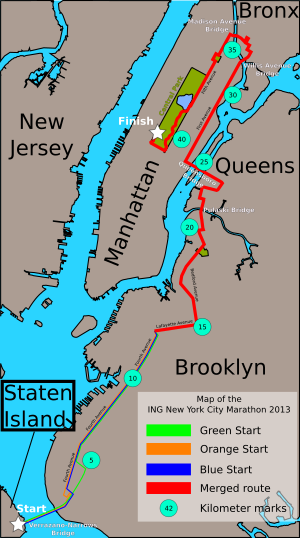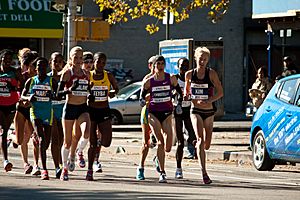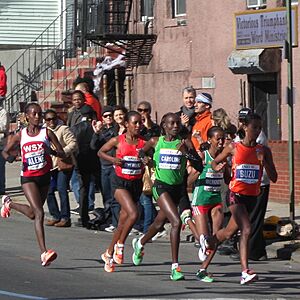New York City Marathon facts for kids
Quick facts for kids New York City Marathon |
|
|---|---|
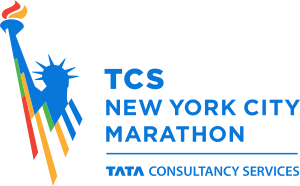
The TCS New York City Marathon logo
|
|
| Date | First Sunday in November |
| Location | New York City, U.S. |
| Event type | Road |
| Distance | Marathon 26.219 miles (42.195 km) |
| Primary sponsor | TCS (since 2013) |
| Established | 1970 |
| Course records | 2:04:58 Tamirat Tola (2023) 2:22:31 Margaret Okayo (2003) |
The New York City Marathon, also known as the TCS New York City Marathon, is a super long-distance running race held every year in New York City. It's a marathon, which means runners cover a distance of 42.195 km or 26.219 mi. This race is famous because it goes through all five parts, or boroughs, of New York City.
It's the biggest marathon in the world! In 2019, over 53,000 people finished the race. Many more want to run it, with almost 100,000 people applying in 2017. It's one of the most important long-distance running events in the United States, alongside the Boston Marathon and Chicago Marathon. It's also part of the World Marathon Majors, a series of the biggest marathons globally.
The New York Road Runners club organizes the race. It has been held every year since 1970, except for two times: in 2012, it was canceled because of Hurricane Sandy, and in 2020, it was canceled due to the COVID-19 pandemic. The race happens on the first Sunday of November. Both professional runners and everyday people from all over the world come to compete.
Because so many people want to run, most participants are chosen through a special lottery system. In 2025, over 200,000 people applied, but only a small percentage were accepted! You can get a guaranteed spot if you meet certain requirements, like running in other races organized by New York Road Runners or raising money for charities.
Race History
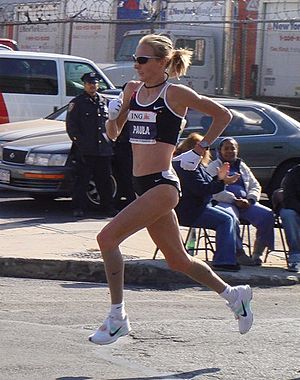
The idea for the New York City Marathon came from George Spitz. The very first race was held on September 13, 1970. It was organized by Fred Lebow and Vincent Chiappetta. Only 127 people started, and they ran several loops around Central Park. Just 55 runners finished, and Gary Muhrcke won in 2 hours, 31 minutes, and 38 seconds. Only about 100 people watched this first race.
Over the years, the marathon became much bigger. In 1976, to celebrate the 200th birthday of the United States, Ted Corbitt suggested that the race should go through all five boroughs of New York City. This idea was a huge success! What was supposed to be a one-time event became the yearly course for the marathon.
In 1976, Dick Traum made history by becoming the first person to finish a marathon with a prosthetic leg. The race became even more popular in 1978 when Norwegian runner Grete Waitz broke the women's world record. She finished in 2 hours, 32 minutes, and 30 seconds. Grete Waitz went on to win the race an amazing nine times!
In 2000, a special division for wheelchair and handcycle athletes was added. Starting in 2002, the fastest women runners get a 35-minute head start before the fastest men and the rest of the runners begin.
The race used to be in late October, but it moved to November in 1986. The hottest race day was in 1979, when it reached 80°F (27°C). The coldest race was in 1995, when it was only 43°F (6°C) with strong winds.
Today, the New York City Marathon is the largest marathon in the world. Nearly two million people line the streets each year to watch and cheer on the runners. The marathon is broadcast live on TV and can also be watched online.
The Course
Original Route
The first New York City Marathon in 1970 was planned by Fred Lebow and Ted Corbitt. It involved running many loops around Central Park. Ted Corbitt, who measured the course, said it was about 26.225 miles long. Runners started and finished near the Tavern-on-the-Green Restaurant.
Five Borough Route
Since 1976, the marathon course covers all five boroughs of New York City.
- Staten Island Start: The race begins on Staten Island, at Fort Wadsworth, near the Verrazzano-Narrows Bridge. This huge bridge is usually only for cars, but it's closed for the race. Runners fill both levels of the bridge, creating an amazing sight at the start.
- Through Brooklyn: After going down the bridge, the course winds through Brooklyn for about 11 miles (18 km). Runners pass through many different neighborhoods like Bay Ridge, Sunset Park, and Williamsburg.
- Into Queens: At about 13.109 miles (21.097 km), runners cross the Pulaski Bridge, which is the halfway point. This bridge takes them into Long Island City in Queens.
- Manhattan Challenge: After about 15.534 miles (25.000 km), runners leave Queens and cross the East River on the lower level of the Queensboro (59th Street) Bridge into Manhattan. Climbing this bridge is one of the hardest parts of the race for many runners.
- The Bronx and Finish: Once in Manhattan, the race goes north on First Avenue. Then, runners cross into The Bronx using the Willis Avenue Bridge. They are only in The Bronx for about one mile before crossing back into Manhattan on the Madison Avenue Bridge. The course then goes south through Harlem and down Fifth Avenue, entering Central Park at East 90th Street. The final mile is along 59th Street/Central Park South, where thousands of fans cheer loudly. The race finishes inside Central Park, near Tavern on the Green. Runners have 8 and a half hours to complete the course.
Race Timing
Since 2008, the race uses a "wave start," meaning runners begin in groups at different times. The fastest women runners start earlier. Your official time is recorded by a computer chip on your bib number. This chip tracks when you cross the start line and the finish line.
Runners also pass timing mats every 5 kilometers (about 3 miles) along the course. This allows people following the race to track a runner's progress.
Different Starting Routes
There are three slightly different routes at the very beginning of the race in Brooklyn. However, all these routes join up at Lafayette Avenue in Brooklyn at Mile 8, and everyone runs the same total distance. Each runner's bib has a color (pink, orange, or blue) that shows which starting route they are assigned to.
Past Marathons: Key Moments
1970s
1970
On September 13, 1970, Gary Muhrcke won the first New York City Marathon in Central Park. Only 55 runners finished.
1972
Six women runners, including Nina Kuscsik, protested a rule that made women start their race ten minutes before or after the men. They sat down for ten minutes at the start line to protest, then ran when the men started. They were called the "NYC Six." Nina Kuscsik won the marathon. The rule was changed later that year.
1974
Norbert Sander and Kathrine Switzer became the only New York City residents to win the marathon.
1976
This was the first year the marathon went through all five boroughs. There were over 2,000 runners! Bill Rodgers won the men's race, and 41-year-old Miki Gorman won the women's race, both setting new course records.
1978
Bill Rodgers won his third straight New York City Marathon. Grete Waitz from Norway set a new course record for women and won her first of nine New York Marathons.
1979
More than 10,000 runners finished the race for the first time. Bill Rodgers won his fourth and final New York City Marathon. Grete Waitz won again, becoming the first woman to finish in under 2 hours and 30 minutes.
1980s
1980
Alberto Salazar won the men's race, setting a new course record. Grete Waitz won her third straight marathon, also setting a new course record for women.
1981
Alberto Salazar's winning time of 2:08:13 was thought to be a world record at first. However, it was later found that the course was a little bit short.
1983
Rod Dixon from New Zealand made an amazing comeback, catching England's Geoff Smith right at the end to win by just 9 seconds.
1984
Orlando Pizzolato won on a hot day, even though he had to stop six times because of heat cramps. Grete Waitz won her sixth marathon.
1985
Orlando Pizzolato and Grete Waitz both won again.
1986
This was the first year the marathon was held in November, which it has been ever since. Gianni Poli of Italy won, and Grete Waitz won for the eighth time.
1987
Ibrahim Hussein of Kenya became the first man from Africa to win the NYC Marathon.
1988
Steve Jones from the United Kingdom won. Grete Waitz won her ninth and final NYC Marathon.
1990s
1990
Douglas Wakiihuri of Kenya won. Wanda Panfil of Poland was the top woman, the only Polish woman to win this event. Grete Waitz finished fourth in her last competitive marathon.
1992
Grete Waitz ran her last New York Marathon with her friend and race co-founder, Fred Lebow. Lebow had brain cancer and passed away two years later. Waitz also passed away from cancer in 2011. Willie Mtolo of South Africa won the men's race, and Lisa Ondieki of Australia set a new course record for women that lasted nine years.
1994
Germán Silva made a wrong turn near the finish line but still managed to win the race by just two seconds! This earned him the nickname "Wrong Way Silva."
1995
This was the coldest NYC Marathon ever, with strong winds. Both the male and female winners from 1994, Germán Silva and Tegla Loroupe, won again. Loroupe was the first woman from Africa to win the NYC Marathon.
1997
More than 30,000 people finished the race for the first time.
2000s
2000
The marathon added a wheelchair division for men and women for the first time.
2001
This marathon happened less than two months after the September 11 attacks. Tesfaye Jifar of Ethiopia set a new course record for men. Margaret Okayo of Kenya won the women's race, also setting a new course record.
2002
Runners from Kenya took the top three spots in the men's race for the first time. Kenyans also won both the men's and women's races.
2003
A record 34,729 people ran the race. Margaret Okayo of Kenya broke her own course record for women, finishing in 2:22:31. Rapper P.Diddy ran for charity and raised $2,000,000 for New York City schools.
2004
Britain's Paula Radcliffe won the women's race by only 4 seconds, the closest finish at that time.
2005
In the closest finish in New York City Marathon history, Paul Tergat of Kenya won by just one second! Jeļena Prokopčuka of Latvia won the women's race.
2006
Marílson Gomes dos Santos of Brazil became the first South American to win the men's race. Jeļena Prokopčuka won the women's race for the second year in a row. Famous cyclist Lance Armstrong also ran the race.
2007
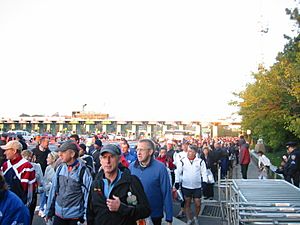
Martin Lel from Kenya won the men's race. Paula Radcliffe from Great Britain won the women's race for her second time.
2008
Marílson Gomes dos Santos won the men's race again, and Paula Radcliffe won her third NYC marathon. Sadly, three runners passed away after the race due to heart conditions.
2009
Meb Keflezighi of the United States won the men's race, becoming the first American winner since 1982. Derartu Tulu of Ethiopia won the women's race, the first Ethiopian woman to do so. This was the first marathon ever with more than 40,000 official finishers.
2010s
2010
Gebregziabher Gebremariam of Ethiopia won the men's race in his very first marathon. Edna Kiplagat won the women's title. A new world record was set for the total number of finishers, with 44,829 people crossing the finish line.
2011
Geoffrey Mutai of Kenya won the men's event, breaking the 10-year-old course record. Firehiwot Dado of Ethiopia won the women's race. Another world record was set for finishers, with 46,795 people. One of the miners rescued from the 2010 Copiapó mining accident in Chile, Edison Peña, also ran the race.
2012
The 2012 marathon was canceled due to Hurricane Sandy. This caused a lot of discussion about whether it was the right decision. Many runners who had planned to participate helped with cleanup efforts instead.
2013
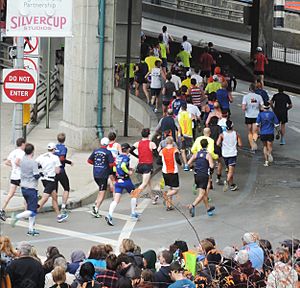
After the 2012 cancellation, Geoffrey Mutai returned and became the first repeat winner in 15 years. Priscah Jeptoo won the women's race.
2014

Tata Consultancy Services became the main sponsor, and the race was renamed the TCS New York City Marathon. Wilson Kipsang and Mary Keitany won the men's and women's races.
2015
Stanley Biwott and Mary Keitany won the men's and women's races.
2016
Ghirmay Ghebreslassie won the men's race, and Mary Keitany won the women's race for the third time.
2017
Geoffrey Kamworor of Kenya won the men's race. Shalane Flanagan was the first American woman to win since 1977.
2018
Lelisa Desisa of Ethiopia won his first New York City Marathon. Mary Keitany won her fourth NYC crown, running the second half of the marathon faster than any woman ever before. A new world record was set for finishers, with 52,812 runners completing the race.
2019
Joyciline Jepkosgei and Geoffrey Kamworor, both from Kenya, won the women's and men's marathons. This year set another world record for finishers, with 53,627 runners.
2020s
2020
The 2020 New York City Marathon was canceled due to the COVID-19 pandemic. Runners could participate in a virtual race instead.
2021
The 50th New York City Marathon was held on November 7, 2021. The number of runners was limited to 33,000 due to safety precautions.
2022
The 2022 New York City Marathon was run on November 6, 2022, with 47,838 finishers.
2023
The 2023 New York City Marathon took place on November 5, 2023, with 51,402 finishers.
2024
The 2024 New York City Marathon took place on November 3, 2024, with over 55,000 runners.
See also
 In Spanish: Maratón de Nueva York para niños
In Spanish: Maratón de Nueva York para niños


